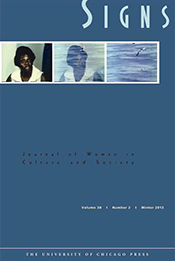 |
||||
| Cover image of Signs: Journal of Women in Culture and Society 38.2, featuring still images from I Am Somebody. Used with permission. | ||||
|
||||
Journal Issue 4.2
I Am Somebody. Directed by Madeline Anderson. Brooklyn: Icarus Films, (1969) 1999. 30 minutes.
Reviewed by Shilyh Warren
When Madeline Anderson made I Am Somebody in 1969 no other documentary film made by, for, and about black women workers existed. The hospital workers featured in Anderson's landmark film came together in the spring of 1969 as part of a labor strike against Medical College and County Hospital in Charleston, South Carolina. They were positioned on the lowest rungs of the medical system, making on average $1.30 per hour. When they started to organize in concert with the New York-based Hospital Workers' Union Local 1199, several of them were fired. The marches, rallies, and picket lines that ensued lasted for over one hundred days and successfully changed the workers' terms of employment. Above all, as a union spokeswoman passionately explains at the end of the film, the over four hundred hospital workers--all but twelve of them women, all of them black--"gained recognition as human beings."
The documentary was commissioned by Local 1199, a union with a visionary understanding of the political power of art.1 Anderson constructed the documentary ex post facto, primarily from television new footage of the strike and its major players.2 Among the national civil rights leaders featured, Coretta Scott King, Andrew Young, and Ralph Abernathy of the Southern Christian Leadership Council figure prominently. One of the film's most poignant moments occurs when the widow of Martin Luther King, Jr., speaks to a crowd about her commitment to black women workers, "perhaps the most discriminated against," and "their crusade for freedom and dignity." While the film celebrates the achievement of the strikers, I Am Somebody also makes visible the ramifications of their activism: from mass arrest and police brutality to domestic strife and personal hardship.
Importantly, I Am Somebody showcases the dominant features of many women's documentary films of the early seventies: a personal voice-over by one of the strikers, interviews with the women that allow them to narrate and self-define their political awakening, and footage that correlates directly with the aural track.3 In the early seventies, these realist strategies held political promise for women documentarians. As contemporary histories of women's liberation attest, the feminist seventies describe a complex era of political activity among diverse women for whom gender mattered but for different reasons and within distinct frameworks of experience, commitment, and oppression. For the women in I Am Somebody gender is inextricably bound to race and class, and for this reason, the film serves a number of salient roles in the feminist classroom: as a historical document of women's political will as organized laborers, as a landmark example of realist feminist documentary production, as a reminder of the complex intersectional landscape of the feminist seventies, and in order to celebrate the historical accomplishments of black women filmmakers and laborers.
1 Cynthia A. Young, Soul Power: Culture, Radicalism, and the Making of a U.S. Third World Left. (Durham, NC: Duke University Press, 2006).
2 Madeline Anderson, "An Interview with Madeline Anderson on the Making of I Am Somebody," Film Library Quarterly 5, no. 1 (1972): 39-41.
3 Shilyh Warren, "Recognition on the Surface of Madeline Anderson's I Am Somebody." Signs: Journal of Women in Culture and Society 38, no. 2 (2013): 353-78.
Shilyh Warren is Assistant Professor at the University of Texas at Dallas where she teaches a range of courses in film studies, including documentary, independent, and experimental cinema, and women's cinema. Her current book project is about US feminist film culture, theory, and practice of the seventies.
Copyright © 2014. All rights reserved.